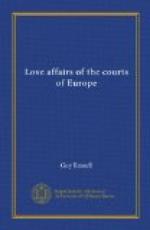“Florizel” was indeed the most splendid Prince in the world, and the most “perfect gentleman.” He was also, though his bride-to-be little knew it, the most dissolute man in Europe, the greatest gambler and voluptuary—a man who was as false to his friends as he was traitor to every woman who crossed his path, a man whom no appeal of honour or mercy could check in his selfish pursuit of pleasure.
“I look through all his life,” Thackeray says, “and recognise but a bow and a grin. I try and take him to pieces, and find silk stockings, padding, stays, a coat with frogs and a fur collar, a star and blue ribbon, a pocket handkerchief prodigiously scented, one of Truefitt’s best nutty brown wigs reeking with oil, a set of teeth and a huge black stock, under-waistcoats, more under-waistcoats, and then—nothing. French ballet-dancers, French cooks, horse-jockeys, buffoons, procuresses, tailors, boxers, fencing-masters, china, jewel and gimcrack-merchants—these were his real companions.”
Such was the husband Princess Caroline came so light-heartedly, with laughter on her lips, from Brunswick to wed, little dreaming of the disillusion and tears that were to await her on the very threshold of the life to which she had looked forward with such high hopes.
We get the first glimpse of Caroline some twelve years earlier, when Sir John Stanley, who was making the grand tour, spent a few weeks at her father’s Court. He speaks of her as a “beautiful girl of fourteen,” and adds, “I did think and dream of her day and night at Brunswick, and for a year afterwards I saw her for hours three or fours times a week, but as a star out of my reach.” Years later he met her again under sadly changed conditions. “One day only,” he writes, “when dining with her and her mother at Blackheath, she smiled at something which had pleased her, and for an instant only I could have fancied she had been the Caroline of fourteen years old—the lovely, pretty Caroline, the girl my eyes had so often rested on, with light and powdered hair hanging in curls on her neck, the lips from which only sweet words seemed as if they would flow, with looks animated, and always simply and modestly dressed.”
Lady Charlotte Campbell, too, gives us a glimpse of her in these early and happier years, before sorrow had laid its defacing hand on her. “The Princess was in her early youth a pretty girl,” Lady Charlotte says, “with fine light hair—very delicately formed features, and a fine complexion—quick, glancing, penetrating eyes, long cut and rather small in the head, which gave them much expression; and a remarkably delicately formed mouth.”
It was in no happy home that the Princess had been cradled one May day in 1768. Her father, Charles William, Duke of Brunswick, was an austere soldier, too much absorbed in his military life and his mistress, to give much thought to his daughters. Her mother, the Duchess Augusta, sister of our own George III., was weak and small-minded, too much occupied in self-indulgence and scandal-talking to trouble about the training of her children.




